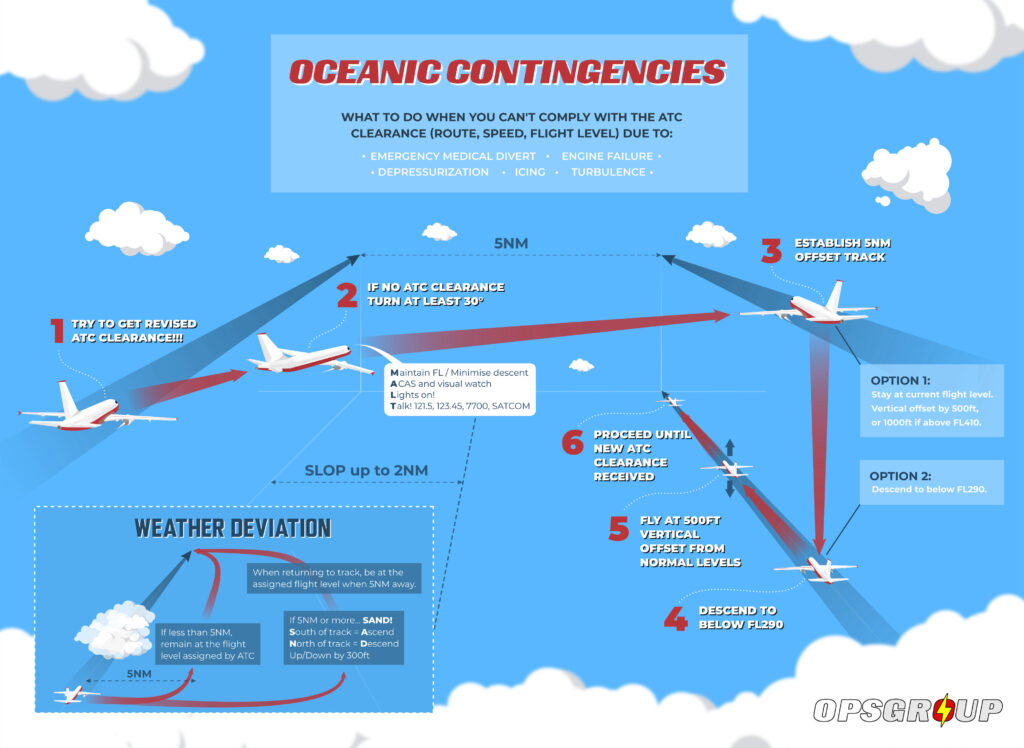From 5 Nov 2020, there will be one standard set of Contingency and Weather Deviation Procedures for all oceanic airspace worldwide.
If you’ve been flying in the North Atlantic Region over the past year and a half, you’ll be familiar with how it works – the new procedures were introduced there back in March 2019, and now they’re being rolled out everywhere.
The FAA has already published a Notice to say that these procedures will take effect in US oceanic airspace from 5 Nov 2020, and ICAO is expected to formally publish the Standard in an update to PANS-ATM (ICAO Doc 4444) to take effect from the same date.
Rarely do we see worldwide oceanic contingency procedures undergo a formal revision. The last time a major revision occurred was in 2006 when ICAO standardized a 15 NM offset executed with a turn of at least 45 degrees. Prior to that, the North Atlantic and the Pacific had used different offset distances and a 90 degree turn.
Wait… what are “contingency procedures”?
These are basically any time you have to do things differently if you need to deviate from your cleared route, and for one reason or another you cannot get permission from ATC first.
Why would you need to bust your clearance? You may not have the ability or capacity to communicate with ATC, or they may not be able to respond to your request quickly enough for a variety of reasons – meteorological conditions (severe turbulence and weather avoidance), aircraft performance, loss of pressurisation, immediate diversion, or a loss of navigational accuracy.
What are the new procedures?
The short answer
Contingency offsets that previously were 15 NM are basically now all 5 NM offsets with a turn of at least 30 degrees (not 45 degrees).
The long answer
Read the FAA Notice.
The slightly less long answer
– Turn at least 30 degrees (reduced from 45) to the left or right of track and establish yourself on a parallel track that is offset by 5nm (reduced from 15).
– The direction of turn is up to you, but you should consider airways around you – the likely direction of other aircraft, the applicable SLOP procedures, the direction of your diversion airport and of course terrain. (If going left or right is a 50/50 choice, going right is probably better – it gets you out of the way of all the SLOP offset traffic that might be coming at you from the opposite direction!)
– When established on your offset track, maintain an altitude that is vertically offset by 500 feet from normal levels (or 1000 feet if above FL410).
– In areas of parallel airways, it is recommended you descend below FL290.
– Watch your TCAS, and if possible, keep your eyes outside for other aircraft.
– Make sure your transponder is set to TA/RA (if able).
– Be seen – turn on as many exterior lights as possible.
– Squawk 7700.
– Try and talk to ATC via voice or CPDLC, and declare a PAN PAN, or MAYDAY.
– Establish comms with other aircraft on 121.5 MHz or 123.45 MHz. Make a position/intention report as you would in TIBA procedures.
The best answer
A picture! So often the best answer. And this one’s pretty neat. Not least because you can click on it, download it, print it out, and put it in your flight bag to take with you. (If you’d also like to laminate it, we’re ok with that).
Weather deviations
If you have to deviate from your assigned track due to anything weather-related, there’s a whole different procedure to follow.
Here’s what to do:
- In the first instance, up the urgency with the phrase “WEATHER DEVIATION REQUIRED.” ATC will attempt to provide separation, and if they can’t they will ask you to advise your intentions.
- If you intend to deviate, let them know. Say something like – “I am deviating under PIC emergency authority. At 5 NM from course I will employ the Weather Deviation contingency.”
Then apply the following:
- Declare a PAN.
- Deviate away from other airways if practical.
- Talk to other aircraft on 121.5 and 123.45.
- Keep an eye on your TCAS and outside.
- Turn on all your exterior lights.
For deviations of less than 5 NM, remain at the flight level assigned by ATC.
For deviations of 5 NM or more, when you are at the 5 NM point initiate a change as follows:
If flying EAST, descend left by 300ft, or climb right by 300ft.
If flying WEST, climb left by 300ft, or descend right by 300ft.
In other words – SAND! (South of track = Ascend, North of track = Descend; Up/Down by 300ft)
Once you are back on track, resume your cleared level. If you’re already deviating and cannot get a clearance to deviate further. Change your level immediately in accordance with the table above.
Turnback procedure
The new guidance has left out any specific reference to how to divert across the flow of traffic or turn-back procedure, and instead simplified it to just “proceed as required by the operational situation”. Turning back would assume you either employ the 5NM offset as per the new contingency procedure, or else get a new revised clearance.
Bottom line
Download the pic, and give the new procedures a good read (they’re not actually that long). Beginning 5 Nov 2020, the new procedures are expected to be implemented. You might want to prepare changes for your ops manuals and checklists too.
More on the topic:
- More: NAT Doc 006/008 Changes 2023
- More: Something to help with NAT Contingencies
- More: FAA Airspace SLOP Mini Guide
- More: Thunderbolts and Lightning, Very Very Frightening
- More: Simthing to Think About
More reading:
- Latest: Crossing the Quiet South: From Australia to Argentina
- Latest: Major runway shutdowns ahead at KVNY/Van Nuys
- Latest: New FAA Airspace Warnings for Venezuela and Puerto Rico
- Safe Airspace: Risk Database
- Weekly Ops Bulletin: Subscribe
- Membership plans: Why join OPSGROUP?












 Get the famous weekly
Get the famous weekly 






I would like to know the procedures by logical sequence for an engine failure
Thanks
One way of rememberers bering whether to climb or descend is as follows.
TURN TOWARDS THE EQUATOR – CLIMB
TURN TOWARDS THE POLE – DESCEND
This works for flights in the southern hemisphere as well.
A way to help remember this is when looking at a profile of the earth the equator is higher than the pole
I hope that helps
This is wrong.
If you are heading EAST, you always descend when turning left, regardless of your hemisphere.
By your system, if you were in the southern hemisphere heading east and turned left (towards the equator), you would climb – that is incorrect.
Hey Chris, excellent synopsis!
One recommendation would be to add the reminder that if you are performing the “weather deviation without a clearance” procedure, and subsequently receive a clearance to deviate, remember you are expected to remove the 300′ and resume your cleared flight level. Seems like common sense, but there are several reports over the years of LHD being filed due to pilots not doing this.
Keep up the good work, y’all!